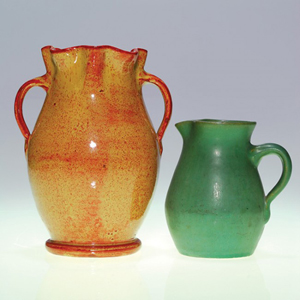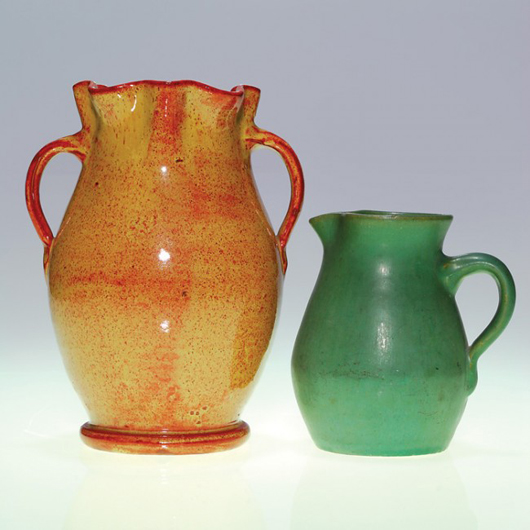
WACO, Ky. (AP) – People around here call him “Speedy” Denny.
Hardly anyone even knows his real name, William. But, the Richmond, Ky. native and Waco resident has used his hometown affiliations to build a collection of more than 100 pieces of Waco Pottery over the past three years.
The last piece of Waco Pottery was turned in 1943, so the pieces are scarce.
“I have an advantage over other collectors in central Kentucky because I know almost everybody in Waco,” Denny said. “I’m real good about beating the bushes, so to speak.”
Although the Waco area may be more famous for Bybee Pottery—the two-centuries old family-run business that suspended operations this year—lesser-known potters had worked from this clay abundant area, Denny said.
“Some potters are average, but every now and then one comes along that is eccentric—just a natural master at it. Waco Pottery just happened to get one of the finest potters in the country,” he said, referring to potter Eb Stone.
The story goes that Stone, a Bybee potter, had a zest for creating artful pottery instead of the dull, more functional pieces that were commonly used in the early 1900s.
Stone was married to a member of the Cornelison family, owners of Bybee Pottery, but artistic and business disagreements led him to ply his trade at nearby Waco Pottery, Denny said.
Between 1922 and 1943, Stone created a different product.
The demand for reusable pottery diminished around that time and was replaced by glass houseware and tin canning. So, potters began to experiment with decorative pots and colorful glazes.
“All of a sudden, there were colors you could put in your kitchen to brighten it up,” Denny said. “Most pieces were made for use around the household. Then came along pottery you could set on your shelf just to look at and put flowers in.”
Stone’s pieces were distinguished by their thinness and smoothness, in contrast to other regional pottery that was thick and ridged. Stone had also created a “strawberry glaze” that was highly sought after and never duplicated, Denny said.
“The strawberry glaze is what Waco pottery is most known for,” he said. “A piece of cobalt blue Waco pottery may sell for $75 dollars, whereas, a strawberry piece of the same size would go for $200 to $250.”
Waco Pottery pieces were fired at 2,100 degrees instead of the standard 1,800 degrees, making the pieces harder and more durable than conventional pottery.
“If you were to flick this pottery with your finger it sounds like you’re striking crystal. The pieces rarely chip because they have been melted down so hard,” Denny said. “It was a notch above the neighbor’s.”
Stone, who died in 1945, stopped making pottery in 1943, and his art died with him, Denny said. John M. Cockrell, the last proprietor of Waco Pottery, continued to make brick and tile until he died in 1969.
A layer of high-quality clay in the Waco area has fueled the pottery business since the arrival of early settlers, Denny said. A sample of the clay was tested at the 1906 World Fair and deemed the highest quality clay in the United States, he said.
Denny has collected most of his pieces from 10 to 15 families in the Waco area. Because Waco Pottery was sold nationally, he also has bought pieces from more than 15 states through the online sales site eBay.
Growing up, Denny would hear someone talk about how “so-and-so bought a little black tea cup for $200,” he said. But, he had never come across Waco Pottery pieces until recently.
Many Waco residents have a piece of Bybee pottery in their homes, said Denny, but Waco Pottery is hard to find. Some of the pieces he has acquired comes from people in their 70s and 80s whose parents had passed the pieces down to them.
“I’m a collector, so what else would I like to collect more than something unique from where I live? I wanted to collect something that was a little hard to find, more challenging, a little pricey … then you really have something. It’s something that’s solid, aging and will hold its value and possibly gain in value. It won’t just fade away.”
Several pieces of Denny’s collection is on display at the “Early 20th Century Central Kentucky Art Pottery of Madison and Fayette Counties” exhibit at the Lexington Public Library’s downtown location. The exhibit is free and will be displayed until Jan. 22.
Information from: Richmond Register, http://www.richmondregister.com
Copyright 2011 Associated Press. All rights reserved. This material may not be published, broadcast, rewritten, or redistributed.
AP-WF-12-19-11 1552GMT
ADDITIONAL IMAGE OF NOTE



